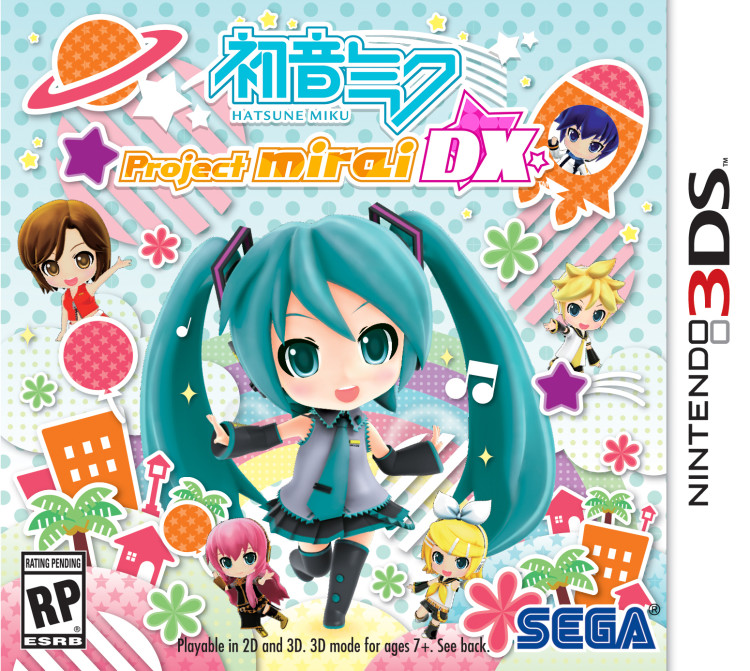
If you read last week’s preview, you’d know that I was feeling quite positive about what I had experienced in playing SEGA’s latest Nintendo 3DS title Hatsune Miku: Project Mirai DX. Now that I’ve had an additional week, I’ve experienced a bit more of what the game has to offer. Rhythm modes have ramped up the difficulty factor, I’ve been able to experience the game’s StreetPass/SpotPass functions, and it was even a certain vocaloid’s birthday. SO without further ado, let’s turn on the lights, grab a mic, and hit the stage for our review of Hatsune Miku: Project Mirai DX!
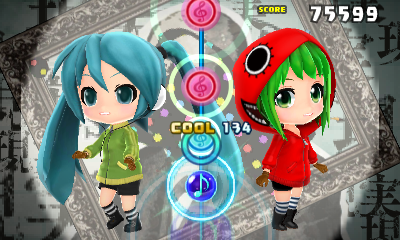
While SEGA and Crypton Future Media’s relationship dates back to 2009 with the release of Hatsune Miku: Project DIVA, the series is relatively new to the West given it wasn’t until March of last year that Hatsune Miku and her vocaloid friends reached Europe and America with the release of Hatsune Miku: Project DIVA F. It’s no surprise that it took so long for the series to make its way to the West, given just how Japanese the franchise is. Hatsune Miku herself is a virtual-diva, a personification of a singing synthesizer application developed by Crypton Future Media. Think of her as half product mascot, half fictional singer. Sort of a cross between Mr. Clean and the Gorillaz lead singer 2-D.
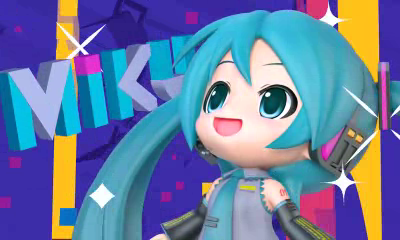 Over in Japan, this sort of thing is common in advertising. Just about every product has a personified mascot, with some mascots (like Miku) taking on a life of their own. While the Western world has their fair share of mascots, like the aforementioned Mr. Clean or the Michelin Tire Man, the concept of them taking on a life of their own and performing live stage shows via hologram or starring in video games is quite weird on the surface. Then again, Cool Spot and Ronald McDonald had their own games so perhaps vocaloids aren’t so different.
Over in Japan, this sort of thing is common in advertising. Just about every product has a personified mascot, with some mascots (like Miku) taking on a life of their own. While the Western world has their fair share of mascots, like the aforementioned Mr. Clean or the Michelin Tire Man, the concept of them taking on a life of their own and performing live stage shows via hologram or starring in video games is quite weird on the surface. Then again, Cool Spot and Ronald McDonald had their own games so perhaps vocaloids aren’t so different.
I should point out that Miku and her friends look quite different from their usual appearance. In Hatsune Miku: Project Mirai DX, the characters appear in their Nendoroid forms. Western SEGA fans should be well aware of Nendoroid, the line of collectible plastic figures created by the Japanese Good Smile Company. The figures, which are roughly four inches tall, feature a variety of limbs, hands, and faces and have covered franchises including Sonic The Hedgehog, Super Mario Bros., Sakura Taisen, Attack on Titan, and Hatsune Miku.
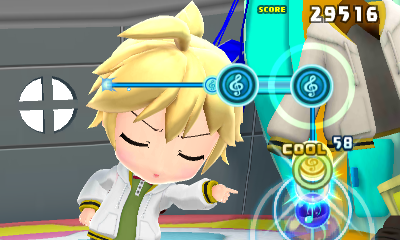 Where Hatsune Miku and her fellow vocaloids stand out from the average personified product character is that they make an easy transition to the world of rhythm music games. Hatsune Miku: Project DIVA and the Hatsune Miku: Project Mirai games aren’t so different from the likes of Samba de Amigo or Rhythm Thief. Music plays, and players tap or push buttons in time to onscreen prompts. In Hatsune Miku: Project Mirai DX, a performance featuring a vocaloid singer plays while blue line travels around and on and off the screen passing command prompts. Players have the option tapping the second screen or pressing the 3DS’s buttons, and the number of buttons, directional arrows, or tapping locations depends on the selected difficulty.
Where Hatsune Miku and her fellow vocaloids stand out from the average personified product character is that they make an easy transition to the world of rhythm music games. Hatsune Miku: Project DIVA and the Hatsune Miku: Project Mirai games aren’t so different from the likes of Samba de Amigo or Rhythm Thief. Music plays, and players tap or push buttons in time to onscreen prompts. In Hatsune Miku: Project Mirai DX, a performance featuring a vocaloid singer plays while blue line travels around and on and off the screen passing command prompts. Players have the option tapping the second screen or pressing the 3DS’s buttons, and the number of buttons, directional arrows, or tapping locations depends on the selected difficulty.
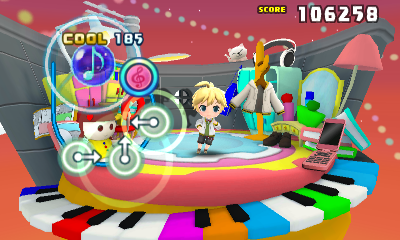 Unlike other rhythm games, the music and in-game character animation doesn’t get better or worse depending on your performance. Bad gameplay simply gets you a game over. Good performance, meanwhile, earns you a passing grade of C to SS and also earns in-game MP currency. As you play through the main game, you unlock new difficulty settings and new songs, with 48 songs in total and several songs that allow the player to change the virtual singer. Overall, the core game has a lot of content and more than enough control settings for players to find their ideal control scheme. The music selection is diverse, covering many genres, but of course each song is sung by a vocaloid in Japanese. If you don’t like how vocaloids sound or if music in another language is not pleasing to your ears, Hatsune Miku: Project Mirai DX will be a hard sell as listening to and playing along with the music is a must. Fortunately, I found several of the tunes to be very catchy and I have my preferred vocaloid voices, so I found the rhythm gameplay to be enjoyable. I was disappointed, however, that there were no vocaloid renditions of classic SEGA songs. The Hatsune Miku arcade games have featured the likes of After Burner and Power Drift, and I think featuring some classic SEGA inspired tunes in this game would have gone a long way.
Unlike other rhythm games, the music and in-game character animation doesn’t get better or worse depending on your performance. Bad gameplay simply gets you a game over. Good performance, meanwhile, earns you a passing grade of C to SS and also earns in-game MP currency. As you play through the main game, you unlock new difficulty settings and new songs, with 48 songs in total and several songs that allow the player to change the virtual singer. Overall, the core game has a lot of content and more than enough control settings for players to find their ideal control scheme. The music selection is diverse, covering many genres, but of course each song is sung by a vocaloid in Japanese. If you don’t like how vocaloids sound or if music in another language is not pleasing to your ears, Hatsune Miku: Project Mirai DX will be a hard sell as listening to and playing along with the music is a must. Fortunately, I found several of the tunes to be very catchy and I have my preferred vocaloid voices, so I found the rhythm gameplay to be enjoyable. I was disappointed, however, that there were no vocaloid renditions of classic SEGA songs. The Hatsune Miku arcade games have featured the likes of After Burner and Power Drift, and I think featuring some classic SEGA inspired tunes in this game would have gone a long way.
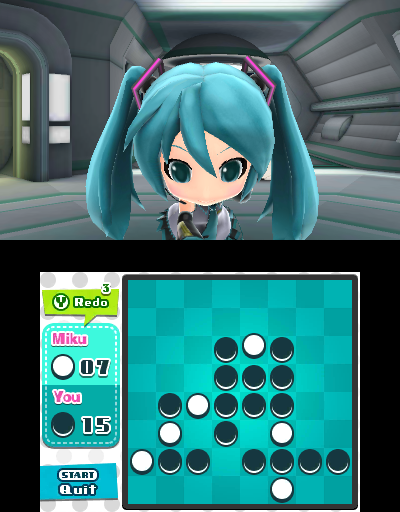 While the rhythm game is the main event in Hatsune Miku: Project Mirai DX, there are a lot of other activities including mini-games, virtual shopping, and Animal Crossing-style room decor. Upon launching the game, players enter their name, choose a vocaloid companion, and select a home room. While your vocaloid friend hangs out in the room on the top screen, players have a bevy of activities to choose from on the bottom screen. Hang out mode allows you to have some fun with your vocaloid friend, be it watching them walk about their room and interact with items you’ve purchased, feeding them snacks, playing a game of reversi, or giving your friend an allowance which allows them to make in-game currency purchases on their own.
While the rhythm game is the main event in Hatsune Miku: Project Mirai DX, there are a lot of other activities including mini-games, virtual shopping, and Animal Crossing-style room decor. Upon launching the game, players enter their name, choose a vocaloid companion, and select a home room. While your vocaloid friend hangs out in the room on the top screen, players have a bevy of activities to choose from on the bottom screen. Hang out mode allows you to have some fun with your vocaloid friend, be it watching them walk about their room and interact with items you’ve purchased, feeding them snacks, playing a game of reversi, or giving your friend an allowance which allows them to make in-game currency purchases on their own.
Going out reveals a small town map with your room, a Dance Studio which allows you to edit dance moves, Mirai Theater where you can watch the game’s many music videos, AR Station which brings the launch edition’s AR cards to life, Mirai Estates which allows you to change your room theme or spend some serious MP on a week long stay at a penthouse or tropical resort, and Mirai Mall. Mirai Mall features a clothing shop which allows you to dress your vocaloid in a variety of costumes, a furniture store where you can buy room decor for your room including Opa Opa, Sonic, and Hang-On and Virtua Fighter 2 arcade machines. If you’re patient, wait long enough with an arcade machine in your room and your vocaloid will walk over and play it!
 Other activities include an alarm clock which puts your vocaloid to bed (not a daily requirement), the option to change vocaloid friends and outfits, a photo album of your many photos, and your collection of profile cards from StreetPass and SpotPass. Profile cards are fun little personalized cards in which you can pose a vocaloid on a background of your choosing and share your name, a custom title (I am “Kindhearted Puyo Popper”), a custom dance created in the Dance Studio, a short custom song composed on the keyboard, and comments that you’ve added on any of the in-game music videos. It’s a fun little way to interact with fellow players. The game also features achievements by way of a stamp book which fills whenever you accomplish a task or do something for the first time.
Other activities include an alarm clock which puts your vocaloid to bed (not a daily requirement), the option to change vocaloid friends and outfits, a photo album of your many photos, and your collection of profile cards from StreetPass and SpotPass. Profile cards are fun little personalized cards in which you can pose a vocaloid on a background of your choosing and share your name, a custom title (I am “Kindhearted Puyo Popper”), a custom dance created in the Dance Studio, a short custom song composed on the keyboard, and comments that you’ve added on any of the in-game music videos. It’s a fun little way to interact with fellow players. The game also features achievements by way of a stamp book which fills whenever you accomplish a task or do something for the first time.
Perhaps the best bonus feature is the inclusion of Puyo Puyo 39, a full-fledged Hatsune Miku themed Puyo Puyo game which features two styles of play as well as solo and local 2-player modes. The addition of Puyo Puyo 39 is important, as it is one of the few times a Puyo Puyo game has released to America (and the first American release to use the name Puyo Puyo rather than Puyo Pop) and is the first Puyo Puyo game since Puyo Pop Fever to release to Europe. While I really wish SEGA gave the Puyo Puyo series the same level of localization love that they give Miku, it’s great to finally have an official release – even if it is a game within a game. As an added bonus, you earn in-game currency when playing Puyo Puyo 39. Play Puyo Puyo to earn enough money to buy a Hang-On arcade machine. It’s every SEGA fan’s dream job!
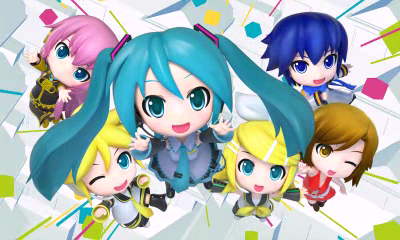
Helping operate a SEGA fan site, I’ve learned firsthand that the Hatsune Miku franchise can be polarizing for fans of SEGA and SEGA’s other franchises. I once was a silent observer, unbiasedly reporting on the games since 2010, but now having finally played Hatsune Miku: Project Mirai DX I understand where both sides are coming from. In the end I had to ask myself one simple question: Did I enjoy the game? The answer is yes, I enjoyed it. While I will likely never buy a vocaloid album or listen to the tracks recreationally, in the context of the game they worked well. The rhythm gameplay is incredibly varied and the bonus modes, while not all as in-depth as I would have hoped for, serve their purpose well to give the game a bit more variety and there is certainly something for everybody. If you are a Hatsune Miku fan, the game is a must buy. If you own a 3DS and want to know what the series is all about, this is a good introductory game. Now if you’ll excuse me, I’m off to play more Puyo Puyo 39 and master hard mode.
Positive:
- Tons of rhythm gameplay modes
- Loads of extra activities
- Puyo Puyo 39 with local multi-player
- Hang-On bike
Negative:
- Must like or be able to tolerate vocaloids
- No online ranking or multiplayer
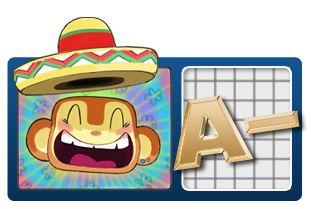 “Project Mirai DX offers plenty of fun and variety, both in gameplay and in bonus modes!”
“Project Mirai DX offers plenty of fun and variety, both in gameplay and in bonus modes!”






Great review! Quick question though, is it true that Hard mode is only avaliable for 6 songs?
Nah, hard is available for all songs. Extreme is what’s only available for six.
Let me tell you tho, extreme for Invisible and Skeleton Lillia look REALLY HARD.
I’m interested in this but I don’t want to pay full retail price for this game… I’ll probably wait a few months…
I miss Cool Spot.
Great review! I’ll need to hear a sample of some of the songs to know if I’ll want to buy it though.
Well madicamaa nuts, how about that.